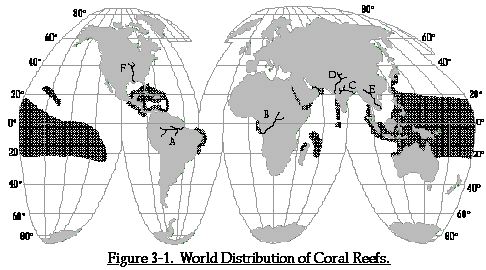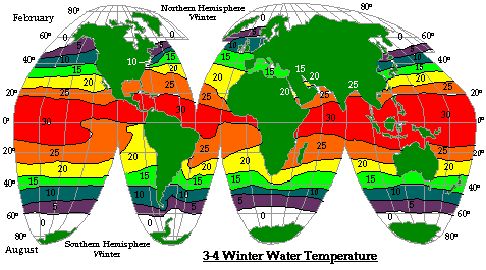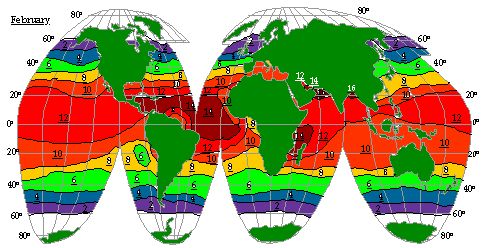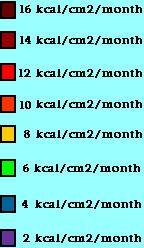World Distribution of Coral Reefs
 BACKGROUND A coral reef is the only marine biological community which resists waves and continually grows and aids in maintaining the shoreline. As the reef builders form reef, many small environments are formed. All these small environments make up the reef community.
BACKGROUND A coral reef is the only marine biological community which resists waves and continually grows and aids in maintaining the shoreline. As the reef builders form reef, many small environments are formed. All these small environments make up the reef community.
Most tropical and subtropical Pacific islands are volcanic islands fringed by reefs or they are barrier reefs with low limestone islands. Reefs form a hard substrate (bottom) in shallow water which allows plants and living corals to flourish. Currents and waves constantly bring nutrients and food to the organisms living there.
The organisms of a coral reef community can be divided into four main groups shown in the table below:
| Types or Reef Organisms |
Examples |
| Reef Builders |
Stony Corals
encrusting Coralline Algae |
| Crack Fillers (sediment producers) |
fragments of coral
Foraminifera (one-celled animals which make shells, e.g. paper shells)
Red, Green and Brown non-encrusting Calcareous Algae
Mollusks
Echinoderms |
| Destructive Agents |
(Waves)
Boring Algae
Boring Sponges
specially adapted fish, such as Parrotfish
Worms
Sea Urchins
Boring Mollusks |
| Passive Residents, who may not greatly affect the reef but may eat reef organisms or be eaten by them |
Many fish
Crustaceans
Worms
Non-Calcareous Algae
Octopus
Anemones |
Coral reefs grow very slowly. In Hawaii, the fastest upward growth of a reef measured to date is 4 mm per year. A continuous upward growth rate is possible only if sea level is rising or if the platform on which the reef rests is sinking. Otherwise, the reef would grow above sea level, which is impossible since reef builders cannot live out of water. On Midway, the oldest island of the Hawaiian, reef rock was found to extend to 380 meters deep in one bore hole. This reef is sitting on volcanic rocks that are 20-25 million years old. The weight of the Midway volcano has caused the island to slowly sink, thus permitting 380 meters of upward reef growth. On the Island of Hawaii, the youngest island in the Hawaiian chain, the only deep reefs are found at the oldest part of the island, near Kawaihae. The rest of this island's coral communities form thin crusts over lava.
ALGAE: The primary producers of food in the coral reef community are algae, so light is a necessary factor in reef growth. Most coral reef polyps contain within their tissues microscopic algae, zooxanthellae, which aid the growth and metabolism of the coral. Zooxanthellae live symbiotically within coral polyps. These algae photosynthesize thereby providing food for the coral.
LIGHT: The ability of light to shine through ocean water is regulated by depth and turbidity. Turbidity refers to suspended particles in water that reduce the ability of light to shine through water. Rivers carrying silt and clay into the ocean or an overabundance of plankton increases turbidity. (Plankton are non-swimming plants and animals). Sometimes a "plankton bloom" produces such high concentrations of organisms that the sea surface is discolored and very turbid.
SALINITY: Corals, and probably other members of the reef community, are sensitive to both temperature and salinity. Corals with Zooxanthellae grow best in water temperatures between 25¡ and 31¡C. However, some corals have been known to survive temperatures as low as 18¡C and as high as 35¡C or more. Corals do not grow vigorously at these extremes.
Coral growth occurs most rapidly in salinities between 34ä and 37ä. Most corals die in salinities below 25ä and above 40ä. (Average sea water contains 35¡ä, read as "parts of dissolved salts per thousand parts of water". This can also be expresses as 3.5% salt).
 Purpose:
Purpose:
To generate and test a hypothesis on the global distribution of coral reefs based upon knowledge of coral requirements for growth and through examination of their range
 Materials:
Materials:
The following materials are needed:
 Colored pencils
Colored pencils
 Three maps:
Three maps:
coral distribution
winter solar radiation
winter ocean temperature
 Procedure:
Procedure:
1. Look below at Figure 3-1, a map of the distribution of coral reefs in the worlds oceans.
a. Why do you think coral reefs are where they are?
b. Why are coral reefs absent where you think they "should be" be present?
c. Write your hypotheses in your lab book.
All dark shaded areas represent where Coral Reef is found. The table below names the major tropical rivers found on this map.
|
A
|
B
|
C
|
D
|
E
|
F
|
| Amazon |
Congo |
Ganges |
Indus |
Mekong |
Mississippi |
* The Mississippi is not tropical, but does influence the Caribbean
2. The following information will enable you to test your hypothesis:
a. Light and Depth- The amount of light that algae and corals receive is very important for coral growth. In clear waters of equatorial regions in the open ocean, reefs do not occur at depths greater that 100m. For example, see Figure 3-2.
| Figure 3-2. Distribution of Light with Depth at Bikini Atoll, 11¡N 165¡E |
Figure 3-3. Unit of Sunlight at Poles Spreads over Larger Surface Area than Equator |
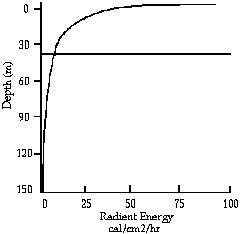 |
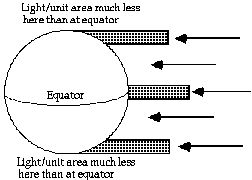 |
b. Light and Latitude- The amount of light hitting a given area decreases from the equator to the poles (Figure 3-3). As a result, the water at the equator is warmer than at higher or lower latitudes (Figure 3-4). Because the presence or absence of coral reefs is probably most influenced by winter temperatures and solar energy, winter values for the northern and southern hemisphere are shown in Figure 3-4 and 3-5. The two halves of maps showing these values have been pasted together so that the lines do not always come together at the equator. Winter in the northern hemisphere is January-March; in the southern hemisphere it is July-September.
Figure 3-4. WINTER WATER TEMP
c. Light and Season- During summer months at a given location, more light strikes the earth's surface than during winter because there are more hours of sunshine. Water temperature is higher in summer than in winter.
d. Light and cloud cover- In areas of extended periods of cloud cover the amount of light reaching the earth's surface is lower, no matter which season or latitude. Latitude, season, and cloud cover determine how much light reaches the earth's surface and is shown in figure 3-5. The units of radiation are in kcal (1000 calories)/cm2/month. One calorie of radiation will heat 1 cc of water 1¡ centigrade.
Figure 3-5. WINTER WATER RADIATION
e. River runoff- All the world's oceans and marginal seas, with the exception of some river mouths, have salinities suitable for coral reef growth ( between 25ä and 40ä). River runoff can reduce salinity which can limit coral growth. Major rivers occur in the tropics and subtropics. As you can see from Table 3-2, the Amazon is "King River" for water runoff. (Each river is shown in Figure 3-1).
|
River |
location |
Water Discharge
(KM3/year)
|
Sediment Transport
(million tons/year)
|
| A |
Amazon |
E. So. America |
5680
|
1600
|
| B |
Congo |
W. Africa |
728
|
480
|
| C |
Ganges |
E. India |
382
|
400
|
| D |
Indus |
W. India |
683
|
190
|
| E |
Mekong |
Malaysia |
346
|
90
|
No data is available for the Mississippi at this time
River runoff can also reduce light penetration in the ocean by increasing the amount of silt and clay suspended in the water. In addition, sediment is deposited on the bottom that forms a soft substrate on which coral reefs cannot grow. However, large volumes of water are not always responsible for large amount of sediment, as seen with the Congo River.
Answer the following questions:
1. Coral reefs can grow to approximately what depth? What is the most important limiting factor which limits coral growth below this depth?
2. Why do you think coral reefs are not present off:
a. West Africa
b. Northwest India
c. Northeast India
d. Northeast South America
e. Northwest South America
f. Eastern Central Pacific
g. Northern Mexico and California
3. How is solar radiation related to ocean surface temperature?
4. Modify your hypothesis based on the information you have been given.
a. Why do you think coral reefs are where they are?
b. Why are coral reefs absent where you think they should be?
 Notes for your Lab Report:
Notes for your Lab Report:
You will be writting a formal lab report on how limiting factors influence the distribution of life using coral reefs as an example. Please keep in mind that the organisms who live in and around the reef (mentioned at the start of this exercise) for the most part have the appearence of coral reef as one of THEIR limiting factors! Be sure to make mention of each limiting factor discussed in the lab and what precisely does it effect: water temperature, solar radiation, salinity, turbidity, etc.
 Purpose:
Purpose:
To generate and test a hypothesis on the global distribution of coral reefs based upon knowledge of coral requirements for growth and through examination of their range.
Concept limits on distribution
Known factors limiting distribution of life globally
Specific biotic and abiotic influences on coral
 Hypothesis:
Hypothesis:
From the exercise
Support your claim through comparison of regions of coral growth and regions which lack corals
Include limiting factors you consider vital
 Procedure:
Procedure:
Describe process used in examining information, graphs, charts and maps
Describe the significance of the information presented in the graphs, charts and maps (how it relates to corals)
Include what factors were examined in specific regions
Address questions 1 and 3 of summary. Use them as model questions to address the information in Table 3-2
 Analysis:
Analysis:
Address summary question 2
Explain general distribution of corals based upon limiting factors
 Conclusion:
Conclusion:
Draw back upon your hypothesis
Illustrate how hypothesis was correct or.....
Suggest reasons why your hypothesis was incorrect
 Last modified 2/1/07
Last modified 2/1/07
 BACKGROUND A coral reef is the only marine biological community which resists waves and continually grows and aids in maintaining the shoreline. As the reef builders form reef, many small environments are formed. All these small environments make up the reef community.
BACKGROUND A coral reef is the only marine biological community which resists waves and continually grows and aids in maintaining the shoreline. As the reef builders form reef, many small environments are formed. All these small environments make up the reef community.  Colored pencils
Colored pencils